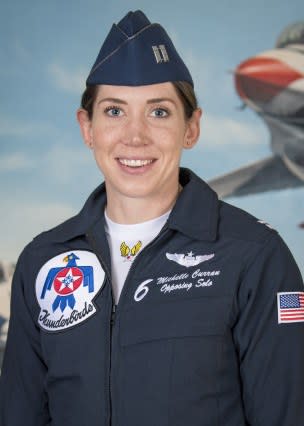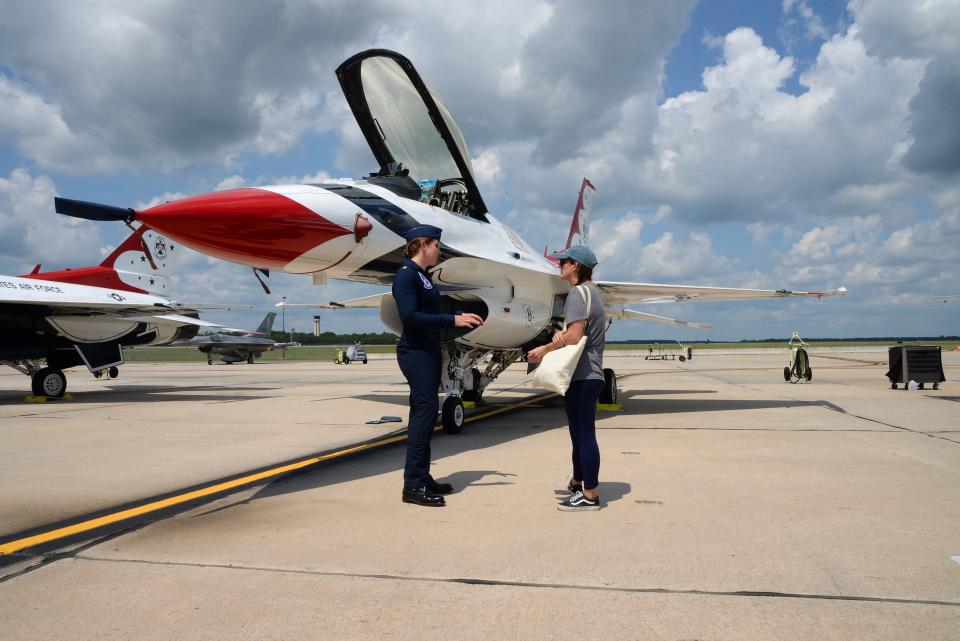A Day With Major Michelle Curran, the Only Female Thunderbird Pilot in the U.S. Air Force
In Captain Marvel, Brie Larson plays Carol Danvers, an Air Force fighter pilot who uses the special powers she gains during an accident to save the galaxy. The movie is fairly realistic—not in the all-powerful superhero scenes, of course, but in the sense that it’s set in 1995. Just two years earlier, women were granted the honor of flying fighter jets by the U.S. Air Force (USAF). So Danvers is a leader in more ways than one.
But in the 26 years we’ve had female fighter pilots in the Air Force, only five have made it to the Thunderbirds. The demonstration squadron boasts some of the world’s most elite fliers, and those skilled enough to make it serve a two-year assignment. They act as the public face for the USAF, performing jaw-dropping maneuvers at air shows around the country.
Today there’s only one female Thunderbird pilot: Major Michelle Curran, a 32-year-old Wisconsin native who flies the coveted Opposing Solo position. It means she’s front and center in one of the most visible squadrons in the military. Next year, her last with the Thunderbirds, she'll get bumped up to Lead Solo, where she'll be showcasing the maximum capabilities of the planes.
Her favorite maneuver is the vertical roll. “It makes a spiral in the sky,” she tells me. “I'll go from 150 feet above the ground to 15,000 in a few seconds while rolling. We have music associated with all our maneuvers and for that one I got to pick the song. I chose [No Doubt’s] ‘I’m Just a Girl.’”
The Air Force turns 72 years old this month. Pair that with Captain Marvel providing more visibility to female pilots earlier this year, and the timing seemed right to experience a day in the life of the only female Thunderbird. To really complete the picture, the Air Force even offered a flight in a F-16 Fighting Falcon aircraft (which, I learn via military.com, is a mainstay of the combat fleet).
I didn’t realize I was nervous about the day ahead, though, until I was halfway to the 177th Fighter Wing of the Atlantic City Air National Guard Base. For one, I’d been told most people who go up in a F-16 for the first time throw up or pass out (for reasons I’ll explain later). One way to mitigate the nauseating effects is to drink lots of water, but that meant double the bathroom breaks on the drive there. So now, I’m not only anxious about puking or passing out in front of a badass pilot but also concerned I’ll be late to meet this badass pilot. On top of that, I worry she might be intimidating. What if I call her by the wrong rank? Do I have to salute? What happens if you unwittingly commit a faux pas in front of one of the best fliers in the world?
But from the moment I meet Curran on the scorching hot tarmac, she is warm and funny. She’d just landed from a Thunderbirds show in Sioux Falls and immediately jokes that she needs to fix her hair after sweating too much on the flight over. “These are not breathable,” she adds, tugging at her flight jumpsuit.

Curran has been in the Air Force for 11 years, but flying wasn’t always her goal. Growing up in a small town of about 4,000 people, she knew she didn’t want to stay there forever, but she worried about how to pay for college. She was applying to scholarship programs when her father suggested looking into the Reserve Officers’ Training Corps (ROTC). She applied, picking the Air Force as her military arm of choice on a bit of a whim. (“I’ve always liked roller-coasters, I’m a thrill-seeker, and I wanted to travel,” she explains.) Once she visited a base and heard the roar of the jets, though, she knew she wanted to pursue the pilot route. She went for it, even competing for a highly coveted pilot spot while still in college. Eventually she was selected. “I was so excited, I called everyone in my family—and none of them answered their phones,” she deadpans. “So that was cool.”
After nearly a decade of active service, including deployments to Afghanistan and Japan, Curran applied to the Thunderbirds. She first saw the squadron during her F-16 training, when they came to her base. There wasn’t a female pilot at the time, but a woman was narrating the air show from the ground and Curran was in awe. “I thought, ‘That’s really cool. She’s badass,’” Curran says. “But I didn’t talk to her because I was so scared of her.” They’re friends now, she adds.
The Thunderbirds don’t see combat, but that doesn’t mean it’s an easy life. The schedule is grueling. Pilots train from March to November, often away from the team’s home base in Las Vegas. Their one free day a week is Wednesday, so Curran—who recently married her husband, a U.S. Marine Corps veteran—says she keeps her time off simple: “Laundry. Hang out with my husband as much as I can. Usually I'll go in the swimming pool in the backyard for a few minutes. Drink a beer. Get ready to wake up early the next morning to go do it again.”
Flying an F-16 also requires an incredibly high degree of athleticism. These pilots are at the mercy of a lot of g-forces—that is, the gravitational force caused by rapid acceleration—and it’s intense on the body. As I mentioned before, people unaccustomed to the feeling often go into g-LOC (g-force induced loss of consciousness) or experience extreme motion sickness. (Being in a spinning cockpit thousands of miles from the ground will do that to you.) In addition to the recommended hydration, pilots must stay in shape. “Most of us work out five days a week,” Curran tells me.
It’s especially important to have strong leg, calf, and thigh muscles—they’re what you squeeze while going into a maneuver with a high amount of g-forces in order to keep the blood in your head from pooling into your lower extremities. The flight surgeon who cleared me for my ride asked if I ever went to SoulCycle or ran marathons, two things that would make me better at handling g-forces. “I live in a fifth-floor walkup,” I offered. I practiced flexing my leg muscles for the next several hours.
If the key to flying F-16s is extensive training and rock-hard leg muscles—both things women have access to—why aren’t there more female Thunderbirds? Curran thinks it might be a perception problem. “The thing that floors me is that some people still don’t realize it’s an option,” she says. “There are people at almost every air show that are like, ‘I didn’t even realize women could fly in combat aircraft.’”
It’s clear this rankles a bit. “It’s been a while!” she says. “This isn’t a new thing.”
Curran’s doing her part to change that perception. “My favorite moment was when this little girl—she was probably six or seven—came up to the autograph line after a show and said, ‘I’m going to take your job.’ I was like, 'Yes! High five!'”
As far as branches of the military go, the Air Force has historically had the most female recruits. Though they’ve only been allowed to fly fighter jets since 1993, women have been enlisting in the USAF proper since 1976. Before that, the WAF—Women in the Air Force—formed in 1948, but WAFs weren’t permitted to fly and instead performed ground duties.
There’s still a long way to go before the Air Force hits total parity, but Curran doesn’t see herself as an outlier. “There’s been a steady uptick of female pilots in general and in the fighter community as well,” she says. She reminds me that not all Thunderbird team members or officers are pilots, and there are many women performing important ground duties. “There’s 12 officers on a team—if you look at the officers alone as a sample, our team next year will have four women,” Curran says. "It’s definitely changing.”
Curran’s not sure yet what she’ll do when her time with the squadron is over, but common next careers for Thunderbirds include flying F-16s in active duty, taking on a leadership role, or making the shift into commercial airlines. She just has one requirement for her life, post-Thunderbirds: “I want to keep flying.”
In the hours following our interview, I’m ushered from a flight surgeon to on-the-ground training for my flight to a fitting for the g-suit to one rather alarming explanation of how to use the plane’s ejector seat. Just in case.
Although Curran isn’t flying with me—her plane, #6, isn’t a two seater—she gave me the excellent advice to braid my hair and tuck it into my suit. (“There have been girls who had really long ponytails get their hair stuck in the seat.”) Instead, I’m riding with Lieutenant Colonel Eric Gorney, a very kind and patient pilot who showed me, using a model plane, exactly what kind of maneuvers we’d be doing once we got into the sky.

U.S. Air Force Thunderbirds #6 gives an interview to Glamour.com
As a team of uniform-clad airmen help me get into the back passenger seat of Thunderbird plane #7, I joke that I feel like Captain Marvel. “I actually helped buckle Brie Larson into this very seat,” one replies.
“Did she throw up on her ride?” I ask.
“No, she did not.” I’m not sure if this is reassuring or not.
Then, with a vertical climb, I’m in the air. As we hop along the New Jersey coastline, experiencing minor Gs, I take in a view of the beach. In a commercial flight, it’s easy to forget that you’re in the sky, but this sensation isn’t lost given the panoramic window atop a tiny cockpit surrounded by clouds. I make a mental note to not take this for granted anymore. We dip around a big thunderstorm and run through a set of increasingly intense maneuvers—360-degree rolls, extended periods of upside-down flight, turns with increasingly high g's. At one point I fly the plane into a barrel roll with Gorney’s help. At another we hit 9 g's—that’s close to the highest g-force these planes can take.
And not to brag, but I don’t throw up or pass out. Initially I credit the breathtaking beauty and the roller-coaster-like thrill of the experience for this, but then I remember another thing the flight surgeon told me: Women tend to have a lower center of gravity, giving them something of a natural advantage against high g-forces. So in a way, women make for more natural fighter pilots. Noted.
Cady Drell is a writer based in New York City.
Originally Appeared on Glamour

